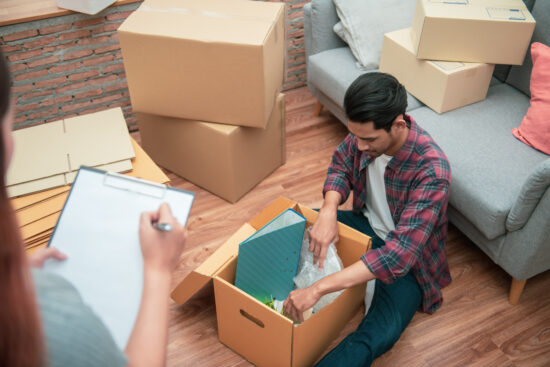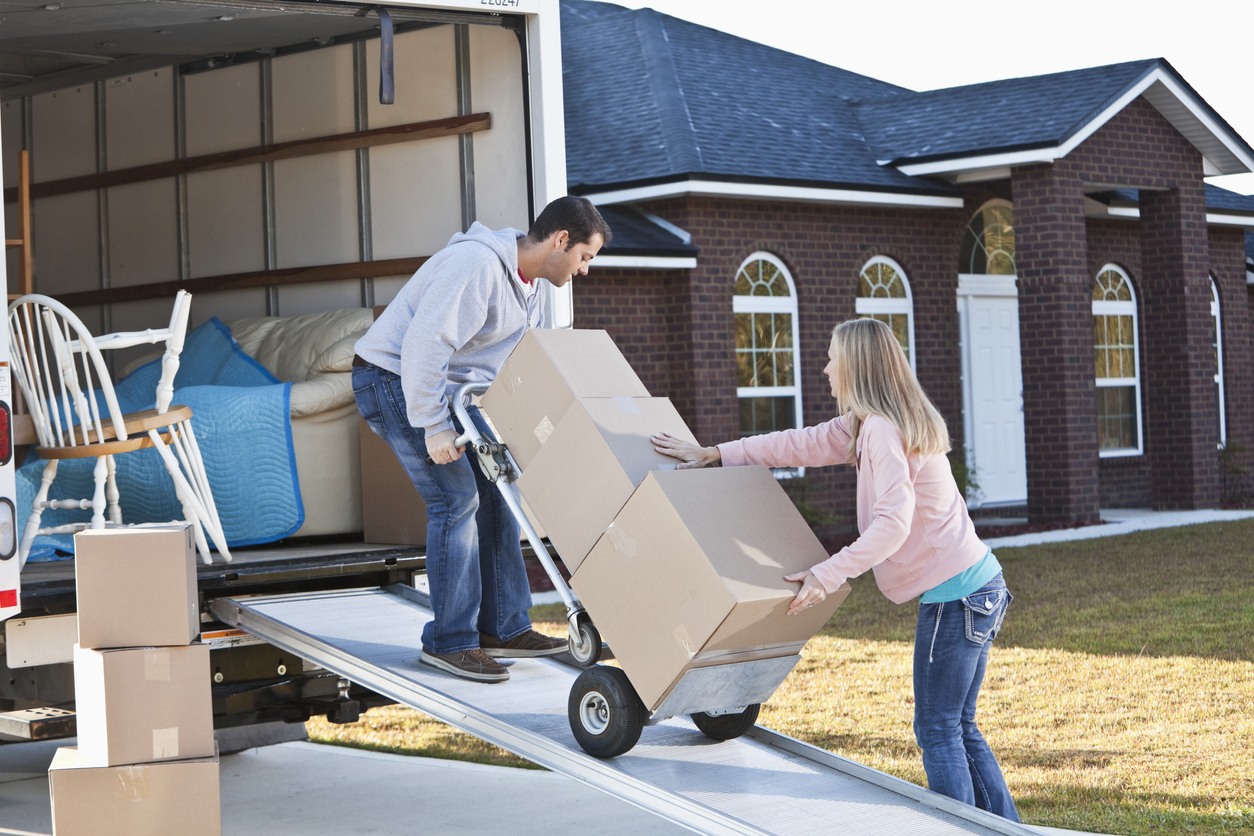No matter how you face it, the complete moving process isn’t an easy job. Hiring professional movers can be expensive (plus, don’t forget to tip). Luckily, there’s another option.
Do-It-Yourself (DIY) moving can be easily achievable if you take the time to prepare properly for the big day and learn the best DIY moving style for your needs. Before you tackle the job, it pays to have an organized plan.
This guide will help you learn everything you need to know for the big day.
DIY Moving Options
When you’re in charge of your move, you have options. If you drive a two-seater, you definitely don’t want to use it for a moving van. Renting a moving truck or moving container is still considerably cheaper than calling in a full service moving company. Consider the tools you have on hand and which DIY moving option will make the most sense for your situation.
Your options include:
Renting a Moving Truck
A moving truck rental has long been a popular choice for DIY moves. The reason is simple. The right-sized truck will likely fit all your belongings, making multiple trips unnecessary. Moving trucks are also relatively easy to load and unload and often come with a loading ramp. The most popular moving truck companies are U-Haul, Penske, and Budget Truck Rentals. Each of these companies offers a variety of truck sizes and different choices for truck pickup and return.
DIY Moving Pro Tip:
Be sure you take proper measurements to ensure you get the right-sized moving truck. No matter how efficient you are at packing, you won’t be able to create space that isn’t there.
Self-Service DIY Moving
This is a DIY option that provides you with the freedom to pack on your schedule and allow someone else to take the responsibility of transporting your belongings. You’ll get a storage container dropped off at your house, so you can pack and load your possessions according to the schedule that works for you. When the container is loaded, the company returns to pick it up and transport your belongings to your new home or a secure storage unit.
The most common companies for storage container rentals are PODS, U-Pack, and Pack-Rat. Container rentals provide you with the convenience of ground-level loading and eliminate the responsibility of driving a large truck.
Going It Alone DIY Moving
If you don’t have the funds to acquire a moving truck or storage container, you’re probably planning a DIY move the old-fashioned way. This means you’re depending on yourself and your personal vehicle to take care of all the heavy lifting. If you’re going it alone, hopefully your move isn’t a long-distance one and you have many friends to help.
This is the cheapest do-it-yourself moving option, but it also means you take on the most responsibility. If your volunteer helpers don’t show up or proper packing methods aren’t used, you could end up with damaged possessions or a delayed move. Full-scale DIY moving means you’re responsible for avoiding injuries, proper packing and loading, and ensuring everyone is safe on the road.
Gathering Supplies for Your DIY Move
Moving your belongings yourself will undoubtedly save you a considerable amount of money. But skimping on proper supplies could cost you the money you’ve saved or even more. When you plan a DIY move, it’s vital that you use the proper supplies to protect your possessions. Begin with a moving checklist to make sure you don’t forget anything and have a successful moving day.
Supplies Needed for Your DIY Moving Day
If you’re thinking that whatever boxes you can find and a random roll of tape will prepare you for packing and moving everything you own, it’s time to think bigger. The right packing and moving supplies will keep your belongings safe, help avoid injury, eliminate hassle, and speed up the laborious tasks of packing and loading. Make sure you start your DIY move with these basic supplies.
- Moving Boxes: If possible, get a variety of different-sized boxes for your move. Overloading boxes can lead to damaged possessions and injuries.
- Packing Tape (With a Dispenser!): Purchase several rolls of quality packing or storage tape to keep your possessions secure through the many touchpoints of your move. A packing tape dispenser (or two) is a priceless tool for saving time while you pack. Your fellow packers will thank you.
- Packing Materials: Yes, you need soft stuff to keep your valuable possessions safe. Packing materials like bubble wrap, foam wrap sheets, and packing paper will keep your fragile items safe during transport.
- Moving Blankets: It’s easy to damage large pieces of furniture when attempting to clear tight corners and doorways.
- Labeling Materials: Masking tape, markers, labeling tape, and stickers all make great materials for reminding you what’s inside your boxes. Your back will thank you when you know where your boxes belong in your new home.
- Cargo Straps or Rope: Prevent heavy items from shifting during loading and transit with cargo straps or ropes.
- Dollies and Hand Trucks: Injured helpers are a big risk during a DIY move. Protect yourself and others by using the proper tools to move heavy furniture and appliances.
- Stretch Wrap: To protect furniture and movable items (like cabinet doors and drawers), a stretch wrap can be a great cover to keep everything in place.
- Tool Set: While you might be planning to move every piece of furniture without any disassembly, your packing/loading space may disagree. A small toolset will make it easy to take apart and reassemble furniture in a pinch.
- Garbage Bags: You can, and should, purge your home of things you no longer need while moving. Make sure you have plenty of heavy-duty garbage bags around for this purpose.
- People: Friends, family members, or the neighbor’s kid who is willing to help out for a few dollars less than professional movers can be a major help when it’s time to empty your home of furniture and various belongings.
DIY Moving Pro Tip:
Borrowing or renting moving equipment can help you save money.
Tips for Scoring the Right Moving Supplies
It’s understandable that you want to save money. Still, that doesn’t mean you should attempt to Frankenstein boxes from the garbage or use every container you can get your hands on for packing. Try these tips to get the right supplies for moving without breaking the bank.
Don’t Pay for Boxes
There are many places where you can get free moving boxes or cheap used moving equipment.
Pack Creatively
Your suitcases, duffel bags, and other travel accessories are going with you to your new home. Use them to pack items like clothing and toiletries.
Use Items You Already Own for Packing Supplies
Linens, pillows, and blankets can be used for cushioning. Your child’s washable markers will work just as well for labeling boxes as those permanent markers you saw at the store.
Buy Tape in Bulk
You’ll need more tape than you think. Instead of risking the hazards of cheap tape, buy quality packing or storage tape in large packages.
Plan Ahead
You likely know you’re moving months before it’s time to pack. Save boxes and packing supplies (hello, free air pillows!) when you order products online during the months leading up to your move.
Packing Tips for Any DIY Move
Proper packing techniques mean you’ll be more likely to survive moving day without injury and your possessions will arrive at your new home or storage space intact. While DIY moving saves money, it’s essential to use proper packing and moving procedures to keep your sanity intact while preparing to move to your new home.
Start Early
Even though you’re not moving for months, there’s no reason to wait until the last minute to start the packing process. Rushed packing leads to cutting corners and making mistakes that could leave you with broken or missing possessions. Start packing belongings that you don’t need for daily use 6 to 8 weeks before moving day.
Purge
If there was ever a time to notice how many things you have that you don’t really use, it’s when you’re preparing to load it all into a truck. During the weeks or months leading to your move, use a variety of techniques to get rid of things you can do without. Sell furniture, donate clothing, or hold a yard sale. Fewer belongings can fit into a smaller truck and limit the work ahead.
Use Unique Resources
The internet can be a wonderful place for both buying things you need and getting rid of things you don’t. Check out Craigslist for cheap and free moving supplies. While you’re at it, list those pieces of furniture you don’t want to take along for the move. Facebook Marketplace has similar options for local buying and selling.
Don’t Skimp
Not all boxes and tape are created equal. Make sure the boxes you use are actual moving boxes. Moving tape should be at least 2-3 inches wide and be labeled for packing, moving, or storage. Also, use moving paper — newspaper can leave ink stains on your possessions. Using cheap packing materials can cost you in the long run when you’re replacing damaged and broken items.
Pack a Carry-On
No matter how you plan to transport your belongings, it’s vital to pack a box of essential items that will travel with you in your personal vehicle. You don’t want to have to search through 100 boxes to find toilet paper and other household items you really can’t do without.
DIY Moving Pro Tip:
Keep expensive items and important documents separate. These items should be labeled carefully and travel with you in your personal vehicle.
Safe Loading and Transport Tips
You finally have all your boxes packed, so the hard part is over — right? Not so fast. Loading and travel can be dangerous if you don’t know what you’re doing. Whether your trip takes you across town or across the country, safe traveling procedures are essential. Use these tips to load and transport your belongings to your new home safely.
Start Early
No matter how prepared you are and how many helpers are involved, moving day takes a lot of time and effort. You can count on unexpected complications and difficult situations, even if you’re only moving across town. A stress-free move occurs only with significant planning and extra time. There’s no penalty for getting to the new house a few hours early, and unpacking will be a breeze when you have more time than expected.
Load Like the Pros
While it may seem tempting to get as many boxes out of the way as possible, it’s essential to load the truck properly. Move heavy items like your refrigerator and washing machine first. These items should be placed near the front of the truck. Follow with large furniture items like couches, chairs, and dressers to line the sides of the truck. When it’s time to load boxes, put the largest, heaviest boxes on the bottom and pack up. Secure everything with straps or ropes as needed.
Don’t Be a Hero
No matter how many pounds you can lift at the gym, moving day is not the time to demonstrate your strength. Use proper lifting techniques and helpful tools to lift and load heavy items. A pulled muscle or back injury can leave you useless for the remainder of the move, or worse, land you in the hospital.
Provide Snacks
You can expect to spend several hours loading the truck. Even if everyone is feeling great, staying hydrated is essential. Be sure to have plenty of water and other non-caffeinated drinks available along with healthy snacks. Even if you plan to provide a meal for movers at the end of the day, it’s vital to keep hydration and blood-sugar levels elevated while completing strenuous tasks.
Hire a Babysitter
Moving is exhausting. If you have small children, hiring a babysitter while you load the truck or even for the duration of the move can make things easier for you and your children. Be sure to book the day several weeks in advance with the babysitter and tip generously. Moving is a stressful time for pets, as well. A pet sitter can keep your pets away from the chaos of packing and loading the truck.
Invest in Moving Insurance
No matter what vehicle you use to transport your belongings, your auto insurance likely won’t be sufficient coverage if something happens on moving day. Even if you never use it, insurance will provide protection and peace of mind. Whether you secure your insurance from a rental truck company or independent provider, make sure you understand the details of the policy.
DIY Moving Pro Tip:
Have your personal vehicle serviced before moving day. Long trips can be hard on vehicles, and the last thing you need is to delay your arrival with a breakdown.
How Do I Drive a Moving Truck?
Take special precautions when driving a large vehicle like a moving truck, like driving slower than usual and noting traffic signs for trucks.
This is an excellent question for any DIY mover. Unlike most large trucks, you don’t need a commercial license to drive a moving truck. This means you can drive one even if you’ve never been behind the wheel of any truck. When you’re driving a moving truck, take these precautions.
- Slow down. You don’t have to drive at the speed limit, and you definitely shouldn’t be speeding. Large, heavy vehicles are more difficult to handle and take longer to stop.
- Watch for traffic signs designed for trucks. Signs about weigh station stops, truck or lane restriction signs, and overhead clearance postings will be important safety markers for your journey.
- Avoid tailgating and apply brakes early. Large, heavy trucks take longer to come to a complete stop than other vehicles.
- Give yourself extra turning room. Large trucks need extra clearance to successfully make a turn.
- Take your time when switching lanes. Always use your turn signal and check your side mirror when switching lanes. A moving truck is longer than your typical vehicle, and you need to allow ample space between yourself and other vehicles.
7 DIY Moving Mistakes to Avoid
It’s no secret that innovative people have been packing up their belongings and moving without the help of professional moving companies for centuries. That doesn’t mean the job is easy. When it comes to DIY moving, the things you shouldn’t do are easily as important as the things you should do. Avoid these mistakes for a safe and effective moving day.
1. Forgetting to Have Your Utilities Turned on in Advance
You don’t want your first night or weekend in your new home to be one without lights, water, or heat. Make sure you consult the local companies responsible for turning on the electricity, water, and even cable and internet at least a week before moving day.
2. Underestimating the Amount of Time Moving Takes
Packing and moving all of your belongings and moving them to another home isn’t easy. That’s why the pros get paid to take care of the whole mess for you. Plenty of time quickly becomes no time as moving day approaches. Putting off packing till the last minute or sleeping in on moving day could lead to mistakes that leave you with damaged or misplaced possessions or even leave you needing your rental truck for an extra day.
3. Assuming You’re Capable of Driving a Moving Truck
A moving truck isn’t a bigger version of your car. It’s an entirely different beast that will be heavily loaded, have limited visibility, and use a lot of gas. If you’ve never driven a large truck, consider hiring a professional or using a storage container for your move. At the very least, you should prepare by learning about the different techniques used when driving large vehicles. Even a local move can get complicated if you can’t get the truck from point A to point B without getting stuck on a difficult turn or low overpass.
4. Overloading Boxes
You may be a packing champion but moving with fewer boxes is a bad idea. Overly heavy boxes lead to injuries, damaged possessions, and a more difficult loading process. Pack heavy items in small boxes, in-between items in medium boxes, and light, airy items (like large cushions and bedspreads) in large boxes. Never pack any of your boxes heavier than 50 pounds.
5. Assuming People Will Be Available and Eager to Help You Move
Gathering helpers to help you pack up your belongings and safely remove them from your old house is a great idea. Asking them at the last minute is a rookie mistake. Sure, your friends and family may be willing to help you move, but they don’t want to cancel previous plans to do it. Moving is a large job, and everyone involved should be properly prepared.
6. Failing to Admit Defeat
Maybe you didn’t start packing early enough. Perhaps you can’t lift the couch on your own. If you’re not able to meet your DIY moving goals for one reason or another, don’t be too proud to ask for help. Call friends or family members for last-minute help. Consider the use of services like HireAHelper, or even hire movers instead of botching your move.
7. Ignoring Safety Rules
Assuming (or pretending) you know how to do everything is never a good idea. Using a questionable rope to lower your couch from a second-floor window may make you a sensation on YouTube, but it’s likely to end in disaster. Instead of blundering through a job you don’t know how to do, take the time to learn how to move furniture and appliances. While you’re at it, check local ordinances for overloaded vehicles, laws about transporting items on the roof of a car, and requirements for driving a moving truck.
A DIY move isn’t impossible, but it’s not a task that should be taken lightly. Proper organization and preparation are key if you hope to get everything to your new home in one piece. It’s also important to get the right materials, including packing tape, for the job. When your move is complete and you’ve had a moment to relax, take time to reach out to everyone who offered a helping hand to offer thanks or even a thoughtful gift. Moving is hard work, but the accomplishment is well worth the struggle.
Additional Moving Resources
Moving and packing guides
- How to Move a Couch
- How to Move a Mattress
- How to Move a Refrigerator
- How to Move a Piano
- How to Move a Pool Table
- How to Pack Shoes for Moving
- How to Pack Dishes and Glasses









